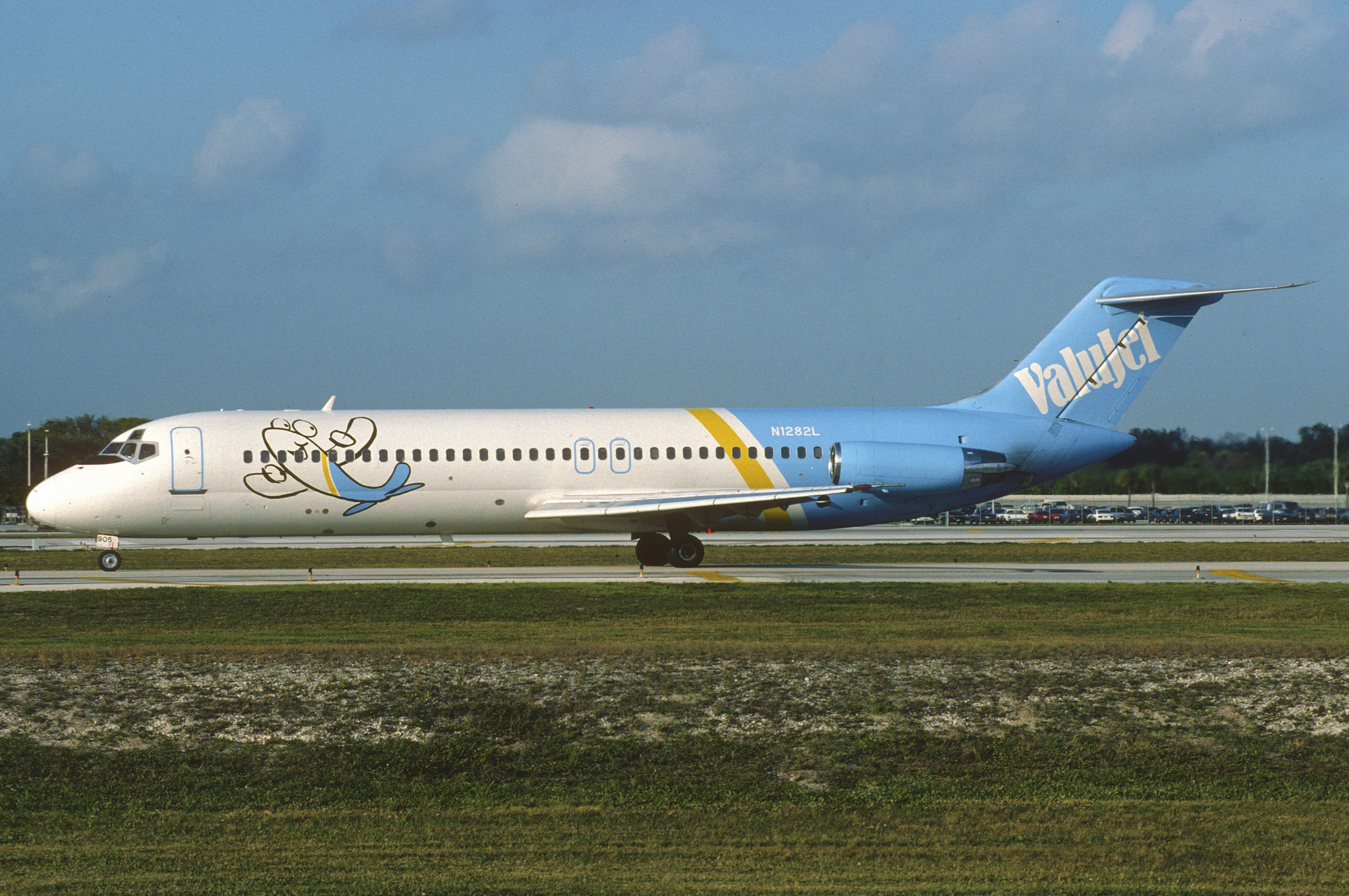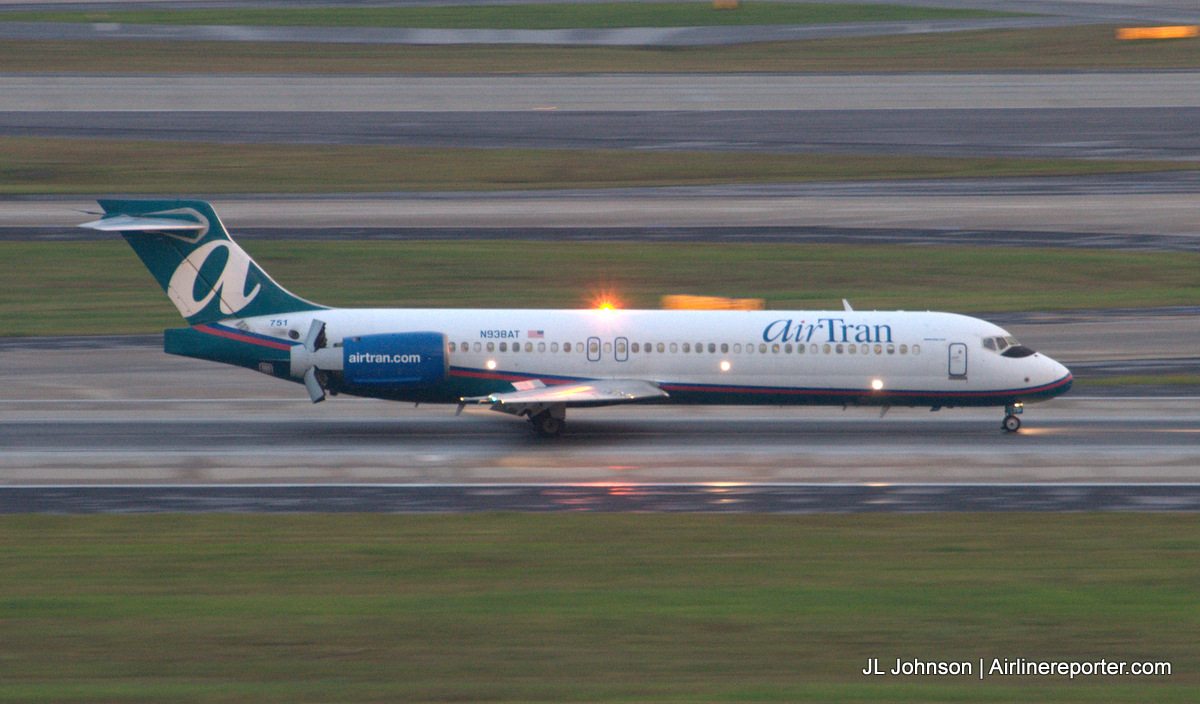
An AirTran Boeing 717 lands in Atlanta
On December 28, 2014, AirTran flight 1 departed Atlanta for Tampa, retracing the airline’s first flight and bringing an end to its remarkable history. I had the honor of being on that last flight and I am excited to share my story. But before I discuss the end of “the big little a” I’d like to first revisit the airline’s history. Because only through knowledge of the airline’s legacy can we truly understand the significance of AirTran’s retirement and integration into Southwest Airlines. So sit back, relax, and enjoy.
ValuJet: Fun and friendly’¦ And perhaps a bit dangerous.
AirTran traces its roots back to ValuJet, an Atlanta-based upstart with dreams of chipping away at Delta’s dominance right in its own backyard. Operations commenced with just a single DC-9, and its first flight was from Atlanta to Tampa on October 26, 1993. In just over a year the airline was solidly profitable and its route map had grown to 17 cities. But fast growth and aggressive cost-cutting practices quickly caught up to the Critter (ValuJet’s FAA call sign.) In the first few years of operation, the small airline had a markedly-high percentage of emergency landings, compared to its peers. In addition, an FAA study indicated that ValuJet dominated the accident data for low-cost carriers.
On May 11, 1996, ValuJet flight 592 went down en-route from Miami to Atlanta; all 110 on board were lost. This tragic, high-profile accident would focus attention on the airline, its maintenance practices, and ultimately lead to its grounding. After a month of investigations by the FAA, which reveled “serious deficiencies in its operation” ValuJet would voluntarily halt operations. But this wasn’t the end for the fledgling airline that had lost its way. Instead, it was just the beginning.
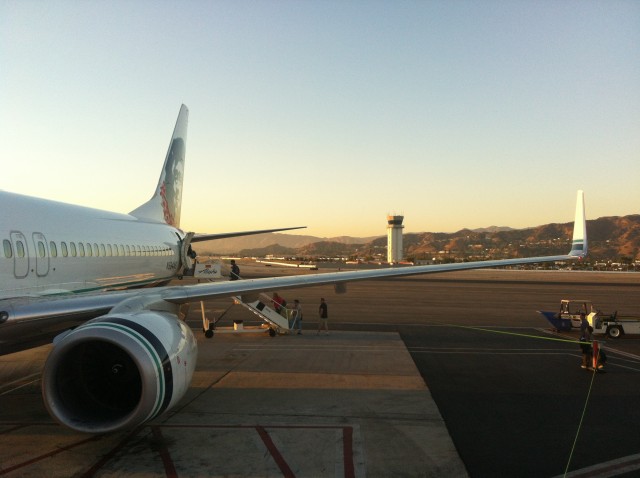
Boarding an Alaska Airlines Boeing 737 at Burbank. Image by Colin Cook.
It used to be that most major airlines shared commonalities in the way they boarded passengers. However it seems that each airline has so their own boarding processes that it’s hard to keep up. Sure, the way an airline boards likely won’t sway a decision on which airline to fly, I wanted to put together a list of how some of the major airlines operate their boarding process.
As one would expect, the majority of airlines give priority boarding to their elite level fliers. Having personally achieved even a low level MVP with Alaska Airlines I can say that I would never want to go back to being just ’œone of the herd.’ While I haven’t gone on a ’œmileage run’, there are many well documented stories of folks taking a quick trip just for the sake of achieving elite-level status.
With precious overhead space and many airlines now charging for checked luggage it’s become a race to get on board as early as possible. While some low cost carriers are now charging for carry-on bags, the major US airlines typically allow one carry-on bag (i.e. a roller bag or other bag for the overhead bin) and one personal item (laptop bag, purse, backpack, etc). Since many travelers are now bringing a large carry-on bag, boarding times have soared. An article in the New York Times suggested that boarding a plane with 140 people in the 1970’s took about 15 minutes which has more than doubled to 30-40 minutes.
Without further adieu, here is how the various airlines handle their boarding procedures (a small note: these are all the boarding requirements as found by AirlineReporter.com at the time of publishing. These change frequently, so please add any changes/ideas to the comments and listen to all gate announcements for proper boarding proceedures):
How does Air Tran board? ’“ This airline’s boarding procedures will undoubtedly change as the integration into Southwest takes place over time. Southwest operates a 737 only fleet and is in the process of subleasing Air Tran’s Boeing 717 planes to Delta. Presently, Air Tran pre-boards unaccompanied minors, passengers traveling with an infant, and passengers needing special assistance prior to general boarding. Like many other airlines, Air Tran utilizes a zone boarding process.
How does Alaska Airlines board? ’“ Being based in the Pacific Northwest, I fly Alaska more than any other airline. Their boarding process is pretty straightforward. They don’t mess around with zones or boarding groups and have a seemingly more streamlined approach. They begin with preboarding ’“ those customers who are traveling with children or need some additional time to get down the jet way. After preboarding, they invite First Class, Alaska Airlines MVP and 75k elite level fliers. Next are passengers seated in row six of the main cabin (bulkhead row at the front of economy) and Alaska MVPs and partner elites. After that, they board from the rear of the plane starting with passengers seated in row 15 and higher. Finally they open to general boarding at that point. It’s a pretty well organized system and tends to work well.
STORY: Flying First Class on Alaska Airlines
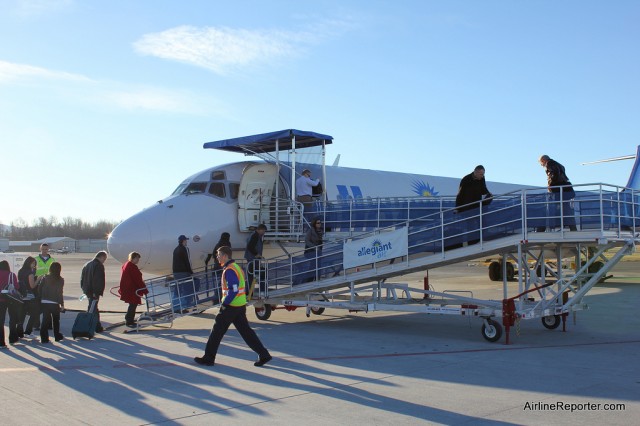
Boarding an Allegiant MD-80 in Bellingham. Image from David Parker Brown / AirlineReporter.com.
How does Allegiant board? ’“ Allegiant offers many different add-ons to their standard fare and does a nice job of providing ala carte service where you can add additional services to their basic fare. Among their options are Priority Boarding for $9.99 (allows you to board first), Premium Seat Selection $9.99 (an assigned seat near the front or exit row), Standard Seat Assignment $6.99 (assigned seat towards the back of the plane). You can certainly opt to fly without paying any of those additional fees, but be prepared to sit in a middle seat. Their boarding process allows people that paid for priority boarding to board first, followed by those who need a little extra time. Then passengers who paid for the standard seat assignment are allowed to board followed by those who do not have seat assignments but have young children. Lastly it goes to open seating and people get to fend for them self to find an open seat.
STORY: Flight review flying Allegiant Airlines
How does American Airlines board? ’“ American is one of the airlines that actually disclose their boarding process on their website. Many airlines do not give a specific process but simply expect you to pay attention when you get to the airport. American employs a process similar to most of the other legacy carriers in that they give priority to elites and then general boarding. Their process consists of preboarding First Class, Uniformed Military, AAdvantage Executive Platinum, and oneworld Emerald. On aircraft with three class service, Business Class is boarded next. The next group consists of AAdvantage Platinum and oneworld Sapphire, followed by Priority AAccess and oneworld Ruby. From there, American is in the home stretch boarding groups 1-4. Of course this could all be changing with the airline merging with US Airways.
STORY: Taking American’s 737 Sky Interior Delivery Flight
How does Delta Air Lines board? ’“ The world’s largest airline by passengers carried and fleet size has developed a good reputation among both business and leisure travelers. They utilize a zone boarding process similar to many of the other large airlines. They first offer preboarding to their Sky Miles Medallion elite level fliers (Diamond, Platinum, and Gold) and passengers traveling in the first class cabin. On international flights they then invite passengers traveling in BusinessElite, Sky Miles Medallion Silver frequent fliers, and partner elites to board. Delta then begins general boarding via a zone process beginning from the rear of the aircraft. Depending on the size of the plane and whether it is an international or domestic flight, Delta can have as many as nine different boarding groups.
How does Frontier Airlines board? ’“ Denver’s hometown airline has been undergoing some big changes in recent years. Frontier uses a zone boarding style similar to many other carriers, beginning with preboarding for passengers with special needs, which include passengers who need assistance and unaccompanied minors. Similarly to Jet Blue’s Silent Boarding group, they do not announce a special boarding for this group. The one nice thing is that you don’t have to make a reservation in advance for the extra time, whereas you do on Jet Blue. Frontier then invites their Summit Members to board which is the top tier of their EarlyReturns frequent flier program. They then begin priority boarding and Zone 1 which includes Ascent members (second tier of EarlyReturns), as well as people traveling on a Classic Plus fare or seated in Stretch seating. Next, they invite families with small children and passengers requiring additional time or assistance to board. They also have a separate boarding group here for people who are not utilizing overhead bins (it pays to pack lightly). After that, they begin boarding with Zone 2, which are passengers in Select seating. Finally, they board Zone 3 which is pretty much anyone else. So while Frontier technically only has three zones, they really have seven different boarding groups.
STORY: Review flying Frontier Airlines to Denver and back
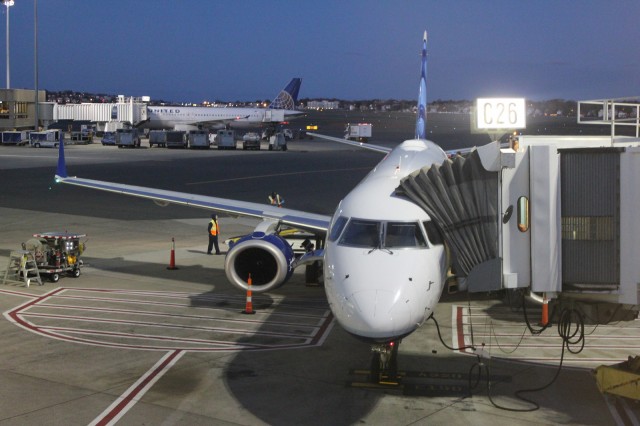
A JetBlue E-190 in Boston. Image from David Parker Brown / AirlineReporter.com.
How does JetBlue board?’“ As is typically true with most things JetBlue, they try to keep their boarding process simple. They begin with pre-boarding which they call Silent Boarding. This is a service that must be requested in advance and is designed for people who have requested or appear to need additional time boarding. The interesting bit is that they do not make a gate announcement (hence the Silent Boarding name), so it is up to you to request this service and show up at the right time. After Silent Boarding they begin priority boarding for Mosaic and Even More Space customers. Mosaic is their elite level program which has many of the same benefits as competitors (priority security lane, preferred seating, 2 free checked bags, bonus points, and dedicated customer service line). Even More Space is an option that you can select when booking and just like it name suggests you get more space.
JetBlue then invites families with children under the age of 2 and other individuals who need additional time to board. It’s interesting that they have their Silent Boarding and then a separate pre-board for people who may need additional time. Finally, they board from the rear of the aircraft forward in five row increments. This begins with individuals in rows 20-25, then 15-25, 10-25, and lastly 5-25.
STORY: Flying JetBlue from the Bahamas to Boston in an E-190
How does Southwest Airlines board? ’“ Southwest is unique since they do not actually assign seats. So it’s still important to get a good boarding group to ensure a good seat and overhead storage. Their overall process contains a boarding group (A, B, or C) and a number (1-60) and they have passengers queue up in the boarding area in a line according to the boarding group and number. Some have called this process a “cattle call,” but really it seems like less people end up standing around waiting to be called than with other methods. Alternatively, you can buy a Business Select or EarlyBird Check-In to be among the first to board. For frequent fliers, it is a pretty simple boarding process, but it seems that people who do not fly often, easily get confused on how to board a Southwest plane.
STORY: Guide to getting a good seat on Southwest Airlines
How does Spirit Airlines board? ’“ Spirit is the ultimate King of low cost travel and their boarding process and baggage policies reflect that. Like Allegiant, their base fares are always amongst the lowest but Spirit is betting you will purchase additional services. They not only have fees for seat selection but also other amenities such as checked baggage and soft drinks on board. Spirit employs a zone boarding process similar to many airlines with some differences. They allow unaccompanied minors and others requiring assistance first, followed by folks sitting in their Big Front Seats (first row or two depending on aircraft that are in a 2-2 layout and have better seat pitch), and then the remaining zones 2, 3, & 4. The one difference is that they board from the front to the back.
How does United Airlines board? ’“ No sooner than I finished writing the original section on United, the airline made yet another change in their boarding process. This marks the fifth time in less than two years that the airline has changed their procedure. This is not surprising as mergers always result in some chaos, but it would seem smart for the airline to stick to one process for a while — hopefully this one will stick.
Under the new process, they begin with pre-boarding of customers with disabilities, Global Services, and uniformed military personnel. Following that, Group 1 is invited to board which included Global Services (for customers that did not pre-board), Premier 1K, Premier Platinum, and their premium cabins. Group 2 is essentially for all of the United and partner elite fliers including Premier Gold and Silver, Star Alliance Gold and Silver, MileagePlus Presidential Plus and Club cardholders, MileagePlus Explorer and Awards cardholders.
It’s interesting that United does not give greater priority to their Gold and Silver level fliers ’“ someone who holds their credit card is given the same boarding priority. United has really been pushing their Explorer credit card so it’s no surprise they used priority boarding as a selling point. United then opens up for groups 3-5 for general boarding from the rear of the aircraft. Unlike other airlines, they no longer give priority boarding to families traveling with infants or young children. Those families must board when their group number is called.
How does US Airways board? ’“ Much like other legacy carriers, US Airways uses a zone boarding process. They begin with preboarding of First Class / Envoy, Preferred members of their Dividend Miles program, and Star Alliance Gold members. After preboarding, zone 1 consists of the bulkhead row and exit row seats without under the seat storage. It’s interesting that they allow exit row seats without under the seat storage to board early. I realize that these folks have responsibilities since they are in the exit row, but does it really take them longer to board?
Zone 2 is made up of US Airways Premier World MasterCard holders, US Airways Visa Signature card holders, ChoiceSeats, and Exit row seats with under-the-seat storage. Much like United, they have given their credit card holders a priority boarding group. At least the elite members of their Dividend Miles program get a higher priority (United has the same boarding priority for Gold and Silver elites as they do for their credit card holders). Finally they board from the rear forward beginning with zones 3-5. It’s a fairly straightforward process which is nice.
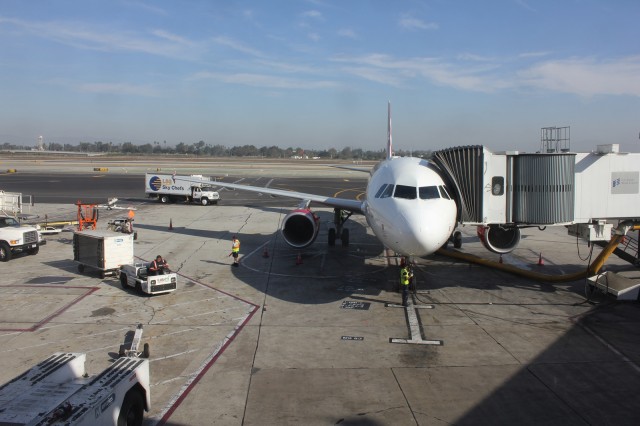
Virgin American Airbus A320 at LAX. Image by David Parker Brown / AirlineReporter.com.
How does Virgin America board? ’“ Virgin American starts with allowing their First Class passengers to board before allowing folks with children and disabled people who need a little more time. Then they move on to Main Cabin Select, which are in the first row of economy and the exit rows so they have more legroom. The Main Cabin Select fare also comes with complimentary food and drinks and one free checked bag. After those two groups, they board the Main Cabin Express group. Ultimately, this is just an add-on that you can purchase to be among the first to board.
Being that I really like to be sit near the front and be able to get off the plane as soon as possible, this fare is quite appealing. Finally, they move on to a group based boarding process, starting with A and moving through the alphabet. I recall on one flight it went groups A-D, but on another it went A-F.
STORY: Flying in Virgin America’s First Class
Hopefully this article can provide some insight the next time you are traveling and are curious about how different airlines board. In the comments, be sure to talk about your boarding experiences and which processes do you like (or hate the most)?
Related links in airline boarding:
 |
This story written by…Colin Cook, Correspondent.Colin is an avid AvGeek who works in finance and is based in the Seattle area. He has an immense passion for aviation and loves to travel as much as possible.
@CRoscoe2121 |
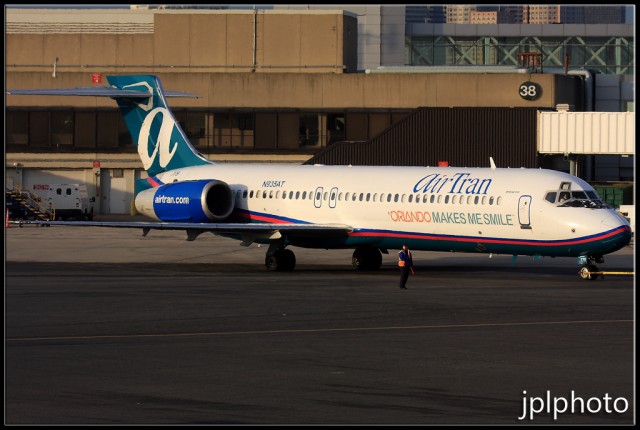
The AirTran Boeing 717s will go from their current livery to Delta's. We will not see one in Southwest livery. Image by Jeremy Dwyer-Lindren.
Yesterday, it was announced that Southwest Airlines will sublease all 88 of their Boeing 717 aircraft from their wholly owned subsidiary, AirTran, to Delta Air Lines. The tentative agreement would move the 717s from Southwest starting in the second half of 2013 and and be finished in 2015.
In September 2010, Southwest announced the purchase of AirTran and many have questioned what Southwest would do with the Boeing 717s, since they only operate a fleet of Boeing 737s.
“This is a very complex transaction that requires time and close coordination with multiple parties. While we do have a tentative agreement with Delta, final details must be completed with all parties before a binding agreement between Delta and Southwest can be completed,” said Mike Van de Ven, Southwest Airlines’ Executive Vice President and Chief Operating Officer.
Southwest plans to re-train 717 AirTran pilots to flying on the 737. All flight attendants and maintenance personal who work for AirTran are already trained on both aircraft types.
Before the move of aircraft can commence, Delta’s pilots will need to approve it. Already, the Master Executive Council (MEC) of the Delta Air Line Pilots Association (ALPA) has given a tentative agreement and pilots will be able to review the change until June 30th.
Delta has stated that the Boeing 717s will be used to replace 50-seat regional jets. “These actions pave the way for us to restructure and upgauge our domestic fleet, which will lower our costs, provide more pilot jobs and improve the onboard experience for our customers,” said Delta CEO Richard Anderson. “The addition of the Boeing 717s, additional large regional jets and the planned replacement of 50-seat aircraft continue Delta’s commitment to operating an efficient, flexible domestic fleet that offers customers even more opportunities to upgrade to our First Class and Economy Comfort cabins.”
Since Delta already has a fleet of around 180 of the DC9/MD80 family of aircraft, it makes sense for them to be interested in taking on the Boeing 717, which is part of the same family.
Of course, the big question for many of us AvGeeks, is will we see a Boeing 717 in Southwest livery before they are handed over to Delta? Unfortunately we will not. “The 717s had not yet begun the retrofit process, so they will transition from AirTran livery to Delta,” Whitney Eichinger with Southwest Public Relations explained to AirlineReporter.com.
Although we may never see a Boeing 717 in Southwest livery in person, luckily there are people out there with great skills to give us an idea of what it would have looked like. I guess we can still be excited to see a 717 in Delta livery, but it won’t be too much different than their DC-9s or MD-80s.
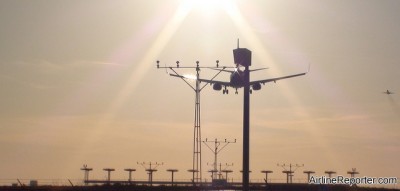
AirTran Boeing 737 landing in Atlanta.
As I am sure you know, Southwest is try to purchase AirTran. This is a very interesting process since we are looking at two low cost carriers becoming one and Southwest taking on a new aircraft type: the Boeing 717.
There are still a lot of questions out there about the merger and I was hoping to get some more insight while hanging out with Southwest in Dallas for their yearly media day. Unfortunately at this point there aren’t a heck of a lot more answers, but I at least have a few more pieces of information.
The big thing to remember is that Southwest and AirTran are still separate companies and competitors. Even though it looks like this buy-out should go through with no issue, AirTran is not about to give up all their secrets until the deal is final. This doesn’t mean that Southwest isn’t working hard already, they just don’t have all the answers right now. Southwest currently has 30 different teams in seven different categories to prepare for the new larger company.
The addition of the Boeing 717 to Southwest’s all Boeing 737 fleet is something that definitely piques my curiosity. Southwest stated they feel this will be one of the smoothest transitions. AirTran already has a good system with their 717 and 737 aircraft and they plan to keep AirTran’s current system of organizing the different planes.
When asked about the Boeing 717 and Boeing 737-500, which are designed to serve similar markets, Southwest stated that the 737-500’s will be coming off lease in 2013-2015. At that time, they will want to have a newer small aircraft to replace them. They made it sound like the Boeing 717 would do that perfectly, but I am not so sure. I wonder if the Boeing 717 is the right aircraft type to provide smaller markets. It seems it might be beneficial for Southwest to look at not being an “all Boeing” airline and start looking at Bombardier C-series aircraft.
Another big interest is Southwest being able to start flying out of Atlanta (ATL). They seem very excited to get AirTran’s slots and are already planning to serve at least 24 new destinations from ATL that AirTran doesn’t currently serve. Southwest stated they aren’t looking to directly complete with any airlines in ATL (aka Delta), but am guessing there is more talk of competition behind closed doors. Southwest explained they hope they could offer airfares as much as 40% lower to ATL than the competition (aka Delta). Now that sounds like competitive talk to me. It looks like ATL will become quite important to Southwest. They stated that Atlanta might quickly become the largest city in their network, flying up to 2,000,000 passengers to the airport.
Some media voiced their concern about loyal AirTran passengers who are used to Business Class, Wi-Fi on all their flights and assigned seats. This is a big change to transition to all economy, Wi-Fi on some aircraft (will be all by mid-2013) and open seating. Southwest didn’t seem too concerned. They stated they know there are quite a few loyal Southwest passengers who would love to fly them into ATL, but just can’t do it right now. They also plan to educate fliers to promote Southwest’s unique brand of service.
Southwest stated that they aren’t looking to eliminate AirTran with the buy out, but that they hope to learn from them in every way they can to make a bigger and better airline. With Southwest announcing they will be flying into larger airports like Newark on top of buying out AirTran, it is anyone’s guess what Southwest might do next. There was talk of flying longer distances possibly Hawaii (which was mentioned half a dozen times), South America and more. I say… game on.
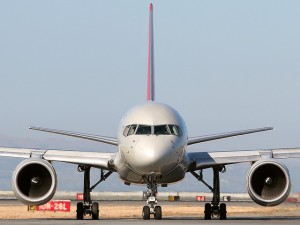
Northwest Airlines Boeing 757
There has been a lot in the news about airline mergers and buy outs. Delta & Northwest, United & Continental and most recently AirTran & Southwest. Some in the media throw around “merger” and “takeover” interchangeably, but they are very different. When two airlines come together, there are two types of sale agreements: the merger and the takeover.
I got an email from a reader (thanks Jay) asking about the difference between an airline merger and take over. I am not a financial professional, but I want to try my best to point out the major differences. If you have any more to add, please feel free to leave a comment!
MERGER:
This is when two companies come together blending their assets, staff, facilities, and so on. After a merger, the original companies cease to exist, and a new company arises instead. Sometimes the new entity will take the name and brand from one of the airlines, but sometimes an entirely new brand can be created.
Delta and Northwest merged, leaving the Delta brand. United and Continental merged, which will leave the United brand. In mergers like these, management needs to work hard to come to certain agreements, figure what/who will be cut and how the new airline will operate. Of course, this can be a very complex process for both airlines to undertake.
TAKE OVER / BUY OUT / ACQUISITIONS
In a takeover, a company is purchased by another company. The purchasing company owns all of the target company’s assets including company aircraft, trademarks, routes and so forth. The original company may be entirely swallowed up, or may operate semi-independently under the umbrella of the acquiring company.
In the case of Southwest buying out AirTran, the AirTran brand will disappear and be absorbed by Southwest. It is not a merger and Southwest will own the assets of AirTran and have complete control. This process is easier than a merger, since management at Southwest has the final say, but they need to successfully share their culture with the employees at AirTran and make sure they feel welcome.
Alright, I hope that helps some!
Image: fiveholer
